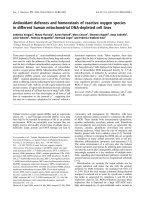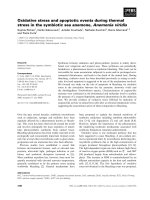Báo cáo sinh học: " Chromosomal localization and activity of nucleolar organizer regions in the dog" pot
Bạn đang xem bản rút gọn của tài liệu. Xem và tải ngay bản đầy đủ của tài liệu tại đây (356.34 KB, 6 trang )
Note
Chromosomal
localization
and
activity
of
nucleolar
organizer
regions
in
the
dog
(Canis
familiaris)
Aldona
Pie&jadnr;kowska
Marek
&jadnr;wito&jadnr;ski
Department
of
Genetics
and
Animal
Breeding,
Agricultural
University
of
Poznan,
Wolynska
33,
60-637
Poznan,
Poland
(Received
2
June
1997;
accepted
5
December
1997)
Abstract -
Using
fluorescent
in
situ
hybridization
on
Q-banded
chromosomes,
nucleolar
organizer
regions
(NORs)
were
localized
on
canine
chromosomes
7qter,
17qter,
Yqter
and
also
terminally
on
a
small
autosome,
not
yet
included
in
the
dog
standard
karyotype.
The
analysis
of
NOR
activity
was
carried
out
on
Ag-I
stained
metaphases
originating
from
27
individuals
(10
males
and
17
females).
The
mean
number
of
silver
stained
NORs
was
6.0
in
males
and
5.3
in
females
and
the
modal
number
was
7
and
6,
respectively.
Interindividual
variability
of
the
mean
and
modal
numbers
of
silver
NORs
was
observed.
The
lowest
individual
mean
number
of
NORs
was
4.2
and
the
highest
7.0,
and
the
modal
value
ranged
from
4
to
7.
©
Inra/Elsevier,
Paris
NOR
/
dog
/
fluorescent
in
situ
hybridization
/
silver
staining
*
Correspondence
and
reprints
Résumé -
Localisation
chromosomique
et
activité
d’organisateurs
nucléolaires
chez
le
chien
(Canis
familiaris).
Les
organisateurs
nucléolaires
(NORs)
des
chromosomes
visualisés
en
bandes
Q
ont
été
localisés
par
hybridation
fluorescente
in
situ
sur
les
chromosomes
canins
7qter,
17qter,
Yqter
et
ainsi
qu’à
l’extrémité
d’un
petit
autosome,
qui
n’est
pas
encore
inclus
dans
le
caryotype
standard
du
chien.
L’activité
des
organisateurs
nucléolaires
a
été
mise
en
évidence
sur
des
métaphases
colorées
par
l’Ag-I
provenant
de
27
individus
(10
mâles
et
17
femelles).
Il
a
été
trouvé
que
le
nombre
moyen
d’organisateurs
nucléolaires
colorés
par
l’argent
était
de
6
chez
les
mâles
et
de
5,3
chez
les
femelles
et
que
la
valeur
modale
était
respectivement
7
et
6.
Une
variabilité
interindividuelle
du
nombre
moyen
et
de
la
valeur
modale
a
été
observée
pour
les
organisateurs
nucléolaires
colorés
par
l’argent.
Le
nombre
moyen
le
plus
bas
d’organisateurs
nucléolaires
chez
un
individu
était
de
4,2
et
le
plus
élevé
de
7,
la
valeur
modale
se
situant
entre
4
et
7.
©
Inra/Elsevier,
Paris
NOR
/
chien
/
hybridation
fluorescente
in
situ
/
coloration
par
l’argent
1.
INTRODUCTION
In
the
nucleolar
organizer
regions
(NORs),
there
are
genes
for
5.8S,
18S
and
28S
ribosomal
RNA.
These
regions
can
be
visualized
by
the
silver
staining
method
or
in
situ
hybridization
with
the
use
of
appropriate
molecular
probes.
Silver
staining
reveals
transcriptionally
active
NORs,
since
precipitation
of
metallic
silver
occurs
only
in
the
regions
where
acid
proteins
are
present
[15].
On
the
other
hand,
in
situ
hybridization
visualizes
all
(active
and
inactive)
NORs
which
are
present
in
a
karyotype.
In
the
family
Canidae,
chromosomal
localization
of
NORs
is
known
for
two
species
with
an
established
standard
karyotype:
the
blue
fox,
Alopex
lagopus
[8]
and
the
silver
fox,
Vulpes
fulvus
[9].
Recently,
a
partial
standard
karyotype
of
the
dog,
comprising
the
21
largest
autosome
pairs
and
sex
chromosomes,
was
established
[18].
This
made
the
development
of
the
physical
mapping
of
the
canine
genome
possible.
The
objective
of
the
present
study
was
the
chromosomal
localization
of
NORs
in
the
dog
karyotype
and
the
analysis
of
their
activity.
This
study
is
a
contribution
to
a
joint
effort
within
the
DogMap
programme
established
in
1993,
which
aimed
at
the
development
of
a
low
density
marker
map
of
the
dog
genome
[13].
2.
MATERIAL
AND
METHODS
The
somatic
chromosomes
were
studied
in
cultured
peripheral
blood
lymphocytes
collected
from
27
crossbred
dogs.
Chromosomal
localization
of
NORs
was
carried
out
with
the
use
of
fluorescent
in
situ
hybridization
(FISH)
on
pre-identified
Q-banded
chromosomes.
For
FISH
experiments,
a
28S
rDNA
human
probe
[16]
was
labelled
with
the
use
of
biotin-
16-dUTP.
Hybridization
of
the
probe
was
carried
out
without
competitor
DNA
and
the
Avidin-FITC
system
was
applied
to
detect
the
hybridization
signals.
Chromosomes
were
identified
according
to
the
nomenclature
presented
in
the
G-
banded
partial
standard
karyotype
[18].
It
was
assumed
that
Q-banding
patterns
of
dog
chromosomes
were
similar
to
the
GTG
ones.
The
activity
of
NORs
was
studied
for
27
individuals
(10
females
and
17
males).
For
each
individual
8
to
10
silver
stained
metaphases
were
analysed.
In
the
case
of
a
single
female,
12
metaphases
were
recorded.
Active
NORs
were
visualized
by
the
Ag-I
banding
technique
[3].
3. RESULTS
FISH
experiments
revealed
NORs
on
three
autosome
pairs
(figure
1)
and
on
the
Y
chromosome.
The
Q-banding
pattern
indicated
that
NORs
were
localized
in
the
terminal
part
of
the
q
arms
of
chromosome
pairs:
7
and
17.
The
third
chromosome
pair,
also
bearing
NORs
in
the
terminal
part
of
the
q
arm,
belongs
to
a
group
of
small
autosomes
not
yet
included
in
the
canine
standard
karyotype.
The
banding
pattern
of
this
chromosome
is
shown
in
figure
1A.
In
the
male
karyotype,
a
NOR
occurred
also
in
the
terminal
part
of
the
long
arm
of
the
Y
chromosome.
detailed
analysis
of
the
silver
deposit
distribution
on
the
chromosomes
of
27
individuals
showed
that
all
seven
NORs
were
transcriptionally
active
(table
1).
The
activity
of
NORs
was
similar
in
all
three
autosome
pairs.
The
majority
of
metaphases
(approx.
79
%)
demonstrated
that
both
NORs
of
a
chromosome
pair
were
active.
The
NOR
on
the
Y
chromosome
showed
a
similar
pattern
of
activity.
Analysis
of
the
number
of
silver
NORs
among
the
27
dogs
showed
a
wide
range
of
variation
(table
II).
The
individual
mean
number
of
silver
deposits
varied
from
4.2
to
6.0
in
females
and
from
4.8
to
7.0
in
males.
The
mean
number
of
NORs
calculated
for
all
males
was
higher
(6.0)
than
for
females
(5.3).
This
was
mainly
due
to
the
NOR
activity
on
the
Y
chromosome.
Similar
variability
was
found
for
the
modal
number,
i.e.
the
most
frequently
observed
number
of
silver
NORs.
4.
DISCUSSION
Nucleolar
organizer
regions
in
the
dog
karyotype
were
studied
by
several
authors.
Unfortunately,
the
obtained
results
were
not
consistent.
Several
reports
showed
the
occurrence
of
silver
stained
NORs
in
the
terminal
part
of
the
long
arms
of
three
autosome
pairs
and
also
on
the
Y
chromosome
[6,
11,
12].
Other
reports
based
on
silver
staining
suggested,
however,
a
higher
number
of
chromosome
pairs
bearing
NORs
[1,
5,
14].
Recently,
the
in
situ
hybridization
approach
was
applied.
Using
a
18S
+
28S
rDNA
human
probe,
Mdkinen
et
al.
[10]
localized
NORs
on
G-banded
chromosomes
7,
17,
a
small
unidentified
autosome
and
the
Y
chromosome.
Also,
Fischer
et
al.
[2]
assigned
NORs
by
the
FISH
method
in
a
female
karyotype
to
three
G-banded
autosome
pairs:
7,
8
and
a
small
unidentified
autosome.
Our
study,
using
the
QFQ/FISH
approach,
confirmed
the
results
obtained
by
Mdkinen
et
al.
[10].
Moreover,
we
present
the
Q/G
pattern
of
the
small
autosome,
not
yet
included
in
the
canine
standard
karyotype.
The
analysis
of
silver
stained
metaphases
of
27
individuals
revealed
high
tran-
scriptional
activity
of
the
NORs.
Similar
results
were
presented
by
Pathak
et
al.
[12]
for
a
single
male
and
Graphodatsky
[4]
for
three
males
and
one
female.
However,
in
the
latter
study
the
Y
chromosome
was
not
indicated
as
a
NOR-bearing
one.
Our
study
also
showed
that
activity
of
NORs
demonstrated
a
wide
interindividual
variability.
The
individual
mean
number
of
NORs
ranged
between
4.2
and
7.0
in
this
study.
The
distribution
of
silver
stained
NORs
has
also
been
analysed
in
other
canids.
It
was
found
that
NORs
were
present
on
seven
chromosomes,
including
the
Y
chromosome,
in
the
raccoon
dog,
Nyctereutes
procyonoides
[7].
In
the
karyotype
of
the
silver
fox,
Vulpes
fulvus,
there
are
three
autosome
pairs
bearing
NORs
which
are
localized
terminally
on
chromosomes
8q,
9q
and
13q
[8].
The
analysis
of
their
activity
showed
that
the
mean
number
of
silver
stained
NORs
was
5.2,
but
the
modal
number
was
6
[17].
The
highest
number
of
NORs
was
found
in
the
karyotype
of
the
blue
fox,
Alopex
lagopus.
There
are
six
chromosome
pairs
with
NORs.
They
were
localized
terminally
on
the
short
arm
of
chromosomes
13,
15,
17,
18,
20
and
22
[9].
ACKNOWLEDGMENTS
The
rDNA
probe
was
kindly
provided
by
Professor
Dr
G.
Stranzinger
and
Dr
R.
Fries
from
the
Swiss
Federal
Institute
of
Technology,
Zurich.
This
study
was
supported
by
The
Committee
for
Scientific
Research,
Poland,
grant:
5S3041206.
REFERENCES
[1]
Delgado
J.V.,
Moreno-Milan
M.,
Alonso
J.,
Alonso
A.,
Rodero
A.,
Distribution
of
NOR
activity
regions
in
dogs,
Proc.
8th
Eur.
Colloq.
Cytogenet.
Domest.
Anim.,
Bristol,
1988,
pp.
129-133.
[2]
Fischer
P.E.,
Holmes
N.G.,
Dickens
H.F.,
Thomas
R.,
Binns
M.M.,
Nacheva
E.P.,
The
application
of
FISH
technique
for
physical
mapping
in
the
dog
(Canis
familiaris),
Mammal
Genome
7
(1996)
37-41.
[3]
Goodpasture
C.,
Bloom
S.E.,
Visualization
of
nucleolar
organizer
regions
in
mam-
malian
chromosomes
using
silver
staining,
Chromosoma
55
(1975)
37-50.
[4]
Graphodatsky
A.S.,
Comparative
cytogenetics
of
three
canids
species
(Carnivora,
Canidae).
III.
Distribution
of nucleolar
organizer
regions,
Genetika
(USSR)
19
(1983)
778-783.
[5]
Howard-Peebles
P.N.,
Howell
W.M.,
Nucleolus
organizer
regions
of
the
canine
kary-
otype,
Cytogenet
Cell.
Genet.
35
(1983)
293-294.
[6]
Kopp
E., Mayr
B., Schleger
W., Nucleolus
organizer
regions
on
chromosomes
of
the
domestic
dog,
J.
Heredity
73
(1982)
73.
[7]
Makinen
A.,
Fredga
K.,
Banding
analyses
of
the
somatic
chromosomes
of
Raccoon
dog;
Nyctereutes
procyonoides,
from
Finland,
Proc.
4th
Eur.
Colloq.
Cytogenet.
Domest.
Anim.,
Uppsala,
Swedish
University
of
Agricultural
Sciences,
Uppsala,
Sweden,
1980,
pp.
420-430.
[8]
Mdkinen
A.,
Gustavsson
L,
Switonski
M.,
Takagi
N.,
The
standard
karyotype
of
the blue
fox
(Alopex
lagopus).
Hereditas
103
(1985)
33-38.
[9]
Makinen
A.,
Kuokkanen
M.T.,
Gustavsson
L,
Isakova
G.K.,
Takagi
N.,
The
stan-
dard
karyotype
of
the
silver
fox
(Vulpes
fulvus),
Hereditas
103
(1985)
171-176.
[10]
Makinen
A.,
Zijlstra
C.,
de
Haan
N.A.,
Mellink
C.H.M.,
Bosma
A.A.,
Genes
en-
coding
18S + 28S
ribosomal
RNA
in
the
dog
are
located
on
three
autosome
pairs
and
the
Y
chromosome,
Anim.
Genet.
27
(suppl
2)
(1996)
70.
[11]
Mayr
B., Geber
G., Auer
H., Kalat
M., Schleger
W.,
Heterochromatin
composition
and
nucleolus
organizer
activity
in
four
canid
species,
Can.
J.
Genet.
Cytol.
28
(1986)
744-753.
[12]
Pathak
S.,
van
Tuinen
P.,
Merry
D.E.,
Heterochromatin,
synaptonemal
complex,
and
NOR
activity
in
the
somatic
and
germ
cells
of
a
male
domestic
dog
(Canis
familiaris),
Cytogenet
Cell.
Genet.
34
(1982)
112-118.
[13]
Report
from
the
First
International
DogMap
Meeting,
Animal
Genetics
24
(1993)
399.
[14]
Ronne
M.,
Poulsan
B.S.,
Shibasaki
Y.,
NOR
association
in
Canis
familiaris.
Genet.
Sel.
Evol.
23
(suppl.
1)
(1991)
191-195.
[15]
Schwarzacher
H.G.,
Wachtler
F.,
Nucleolus
organizer
regions
and
nucleoli,
Hum.
Genet.
63
(1983)
89-99.
[16]
Sylvester
J.E.,
Whiteman
D.A.,
Podolsky
R.,
Pozsgay
J.M.,
Respees
J.,
Schmickel
R.D.,
The
human
ribosomal
RNA
genes:
structure
and
organization
of
the
complete
unit,
Hum.
Genet.
73
(1986)
193-198.
[17]
Switonski
M.,
B
chromosomes
in
fox
(Vulpes
vulpes),
their
nature,
distribution,
inheritance
and
effects,
Roczniki
Akademii
Rolniczej
w
Poznaniu
174
(1988)
(in
Polish).
[18]
Switonski
M.,
Riemann
N.,
Bosma
A.A.,
Long
S.,
Bartnitzke
S.,
Pienkowska
A.,
Moreno-Milan
M.M.,
Fischer
P.,
Report
on
the
progress
of
standardization
of
the
G-banded
canine
(Canis
familiaris)
karyotype.
Chrom.
Res.
4
(1996)
306-309.









